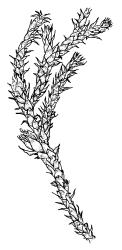Plants medium-sized to robust, creeping, yellow- or grey-green, usually on rock or tree bases. Protonema globular. Stems creeping or weakly ascendant, freely and irregularly branched, often producing slender microphyllous stolons, in cross-section lacking a central strand. Shoots julaceous or hoary when dry. Leaves crowded, appressed in lower portions (but often with spreading hair-points) when dry, spreading or secund when moist, mostly oblong-ovate, acute, acuminate, or piliferous, often hoary and plicate, ecostate, mostly recurved, entire or serrulate, often decurrent. Upper laminal cells quadrate, oblong, or rhombic, papillose on both surfaces, mostly incrassate and porose, becoming elongate towards leaf base; basal marginal cells differentiated, mostly quadrate in many rows. Paraphyllia absent. Pseudoparaphyllia absent or filamentous, reportedly papillose.
Monoicous. Setae mostly short, occasionally elongate; capsules immersed (in N.Z. taxa) or exserted, erect, symmetric, mostly subglobose, gymnostomous; stomata superficial; annulus lacking; operculum plano-convex, umbonate, or long-rostrate. Calyptra mitrate or cucullate. Spores medium-sized.
The relationships and circumscription of the Hedwigiaceae have been, and remain, controversial. The Hedwigiaceae were placed in the order Isobryales by Brotherus (1925). He subdivided the family into 3 subfamilies with the Hedwigioideae the largest, with 4 genera. De Luna (1995) re-evaluated the limits of the family and its relationships; he considered the 4 genera (Hedwigia, Hedwigidium, Braunia, and Pseudobraunia) placed by Brotherus in the Hedwigioideae to comprise the monophyletic family Hedwigiaceae, which he considered supported by 2 unique synapomorphies: papillose pseudoparaphyllia and globular protonema. De Luna’s circumscription of the family agrees with that subsequently adopted by Goffinet et al. (2009), who placed the family in the order Hedwigiales.
Hedwigia and Hedwigidium are small genera with representatives in New Zealand. Braunia is a tropical genus of c. 23 species occurring on rock in the Americas, Africa, and Asia. Pseudobraunia is a monotypic genus confined to western North America. A fifth genus, Bryowijkia (=Cleistostoma), of eastern Asia, is also sometimes placed in this family.
The distinctive globular protonemata, mainly composed of rounded cells, were illustrated by de Luna (1990), using cultured material.
While the genus Rhacocarpus was placed in the Hedwigiaceae by Brotherus (1925), there is an increasing consensus that it deserves recognition at the family level, in large part because of its distinctive laminal cell ornamentation (see Barthlott & Schultze-Motel 1981). According to Crum (1994, p. 667) Rhacocarpus resembles the Hedwigiaceae "only in lacking a costa and a peristome". De Luna (1990) demonstrated that the protonema of Rhacocarpus was not globular. The removal of the Rhacocarpaceae from the Hedwigiaceae was advocated by de Luna (1995) and followed by Goffinet et al. (2009).
| 1 | Shoots not julaceous when dry; leaves mostly ending in broad white tips, with margins plane throughout or weakly reflexed near base; upper laminal cells with 1–3 coarse, simple, forked, stellate, or peltate papillae on both surfaces; cells of leaf apices clearly differentiated from upper laminal cells, elongate-fusiform and with numerous unforked papillae; perichaetial leaves ciliate | Hedwigia |
| 1' | Shoots julaceous when dry; leaves lacking white or hyaline tips, with margins strongly reflexed nearly throughout; upper laminal cells with numerous simple and usually obscure papillae; cells of leaf apices not differentiated from upper laminal cells; perichaetial leaves entire | Hedwigidium |
| Category | Number |
|---|---|
| Indigenous (Non-endemic) | 2 |
| Total | 2 |




